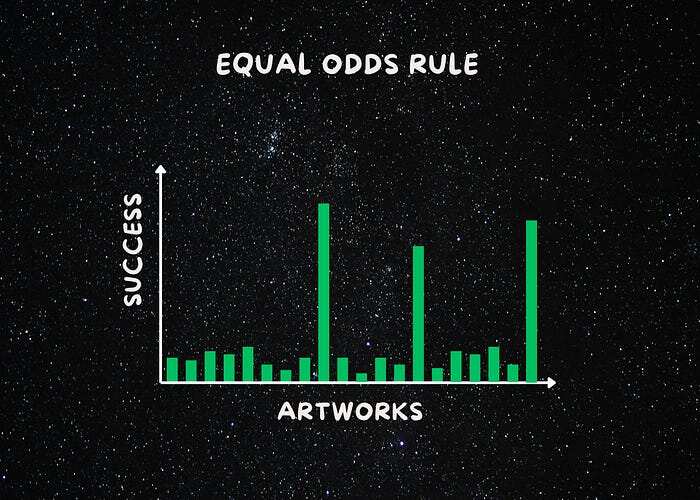The Mathematical Rule That Predicts Your Creative Success
Medium | 16.11.2025 21:05
The Mathematical Rule That Predicts Your Creative Success
And why ignoring it keeps talented creators invisible
7 min read
·
Just now
--
Most people don’t fail for lack of talent — they fail for lack of volume.
We’re obsessed with creating the perfect piece: the painting that becomes iconic, the book that becomes a bestseller, the song that travels around the world. The paradox is cruel: the more you obsess over your masterpiece, the further you push it away.
Because what determines whether you’ll produce something meaningful is not your intuition, nor your genius, nor even your discipline.
It’s simple math. It’s playing with probabilities.
Science calls it the Equal Odds Rule: every time you create something, you have the same probability of producing garbage as you do of creating a great success.
And that’s the key to discovering your creative talent.

The mathematician who understood it
Paul Erdős was not a common person.
He lived like a nomad with two suitcases, worked up to 19 hours a day, and survived on coffee and amphetamines. He was the most prolific mathematician of the 20th century, with more than 1,500 published papers and over 500 collaborations worldwide. His name appears in nearly every branch of modern mathematics.
But here’s the surprising part.
The vast majority of those 1,500 papers were forgotten. They never changed anything. They were never cited by other authors. They were archived in journals no one reads anymore and still sit there gathering dust.
Does that mean Erdős wasted his time? Quite the opposite.
It was precisely thanks to that colossal volume that he was able to discover legendary proofs, develop Ramsey theory, and solve conjectures that had troubled generations of mathematicians for centuries.
His genius wasn’t creating one masterpiece after another.
His genius was multiplying his chances of creating them. And that’s the key…

The Equal Odds Rule
In 1977, psychologist Dean Keith Simonton put into words what artists and scientists had intuited for centuries.
He called it the Equal Odds Rule (Simonton, 1997).
In simple terms: every creative work you produce has the same probability of being good or bad, regardless of your track record. It doesn’t matter if you’re a Nobel Prize winner or a beginner — your next attempt might be brilliant or irrelevant. It’s impossible to predict which idea will change the world.
You can’t control success. What you can control is how many times you try.
Math favors the consistent — it’s a Pareto distribution.
1% of your work will get 99% of the recognition.


The psychology behind the rule
The rule comes from the idea of “blind variation and selective retention” (Campbell, 1960).
In simple terms: the creative process works like evolution. You generate many random mutations (ideas), and only the fittest survive. But the most compelling evidence came in 2015, when Rex Jung and his team showed through neuroimaging what had long been suspected: more ideas lead to a higher probability of producing something truly creative.
Those who generated more ideas in creativity tests ended up with more creative ideas than those who said fewer and tried to choose only their best ones.
Creativity is not a spark.
It’s a sea of failed attempts from which, occasionally, great treasures emerge.

The illusion of the “genius”
This is where most of us stumble.
We’re taught stories of geniuses who produced a single immortal work and that was it.
- Leonardo painting the Mona Lisa.
- Einstein formulating the theory of relativity.
- Picasso inventing cubism.
The narrative sells us the exception and silences everything it took to get there.
What we don’t hear is that Leonardo left dozens of unfinished projects, that Einstein published countless minor papers no one remembers today, or that Picasso created more than 20,000 works before being called a “genius” (McCully & Marilyn, 2025).
The genius myth is a seductive trap.
It convinces you that you’re not enough and steals your chance to discover your own power. While we wait for the perfect idea, we waste the only strategy that actually works: relentless attempts.
True creative talent is revealed in the process, not the exception.

How to use the Equal Odds Rule
Here are 3 keys to apply the rule in your creative work.
1. Create a volume system
A simple example: I write one article every two days.
That’s about 15 a month, more than 180 a year. Of those, maybe 2 or 3 a month turn into hits: they get more readers, spark conversations, spread across Substack, and help more people discover my work.
Can I know in advance which ones will succeed? Never.
That’s the essence of the Equal Odds Rule. The only thing under my control is maintaining the writing habit. And that habit (the consistency of publishing every few days) is what increases my odds of creating something valuable.
The more you dig in the mine, the more likely you are to find a nugget of gold.
2. Embrace mediocre work
Often I finish an article, review it, and think: there’s nothing special here.
I publish it anyway. Sometimes it gets lost in the noise and receives just a couple of comments. Other times, that exact piece turns out to be the one most shared and the one that brings me the most messages from readers thanking me for writing it. Let’s stop prejudging and keep creating.
The compass is not inside me — it’s in the world’s response.
3. Focus on the process
An article every two days sounds exhausting, but for me it’s the best therapy.
I don’t write thinking “this will be the text that makes me famous.” I write because I enjoy it, and that passion brings me back to the keyboard day after day. Sometimes the words shine, sometimes they don’t. What matters is that the habit continues. And every time I honor that habit, I increase the probability that the next piece will resonate.
The process is my passion. The result is a consequence.
This applies to almost anything you do in life.

The value of creating garbage
Paul Erdős knew this, and all great artists know it too.
To reach a masterpiece, you must cross a desert of creative garbage — hundreds of failed drafts, weak ideas, clumsy attempts. That desert is the price of gold. Everyone wants immediate recognition, but the rule only understands numbers.
If you’re willing to create a lot, even if most of it is worthless, you’ve understood the game.
Your talent doesn’t reveal itself in your first work.
And maybe not in your 100th.
Or your 1,000th.
Just create.

✍️ Your turn: What daily habit could you build that would dramatically increase your odds of creative success?
💭 Quote of the day: “If you want to be a writer, you must do two things above all others: read a lot and write a lot.” — Stephen King, On Writing: A Memoir of the Craft
🌱 Here I plant ideas. In the newsletter, I make them grow.
Daily insights on self-development, writing, and psychology — straight to your inbox. If you liked this, you’ll love the newsletter. 🌿📩
👉 Join 43.000+ readers: Mental Garden
See you in the next letter, take care! 👋

Referencias 📚
- Campbell, D. T. (1960). Blind variation and selective retentions in creative thought as in other knowledge processes. Psychological Review, 67(6), 380–400. URL
- Jung, R. E., Wertz, C. J., Meadows, C. A., Ryman, S. G., Vakhtin, A. A., & Flores, R. A. (2015). Quantity yields quality when it comes to creativity: a brain and behavioral test of the equal-odds rule. Frontiers In Psychology, 6. URL
- McCully, & Marilyn. (2025). Pablo Picasso | Biography, Cubism, Famous Paintings, Guernica, & Facts. Encyclopedia Britannica. URL
- Simonton, D. K. (1997). Creative productivity: A predictive and explanatory model of career trajectories and landmarks. Psychological Review, 104(1), 66–89. URL









